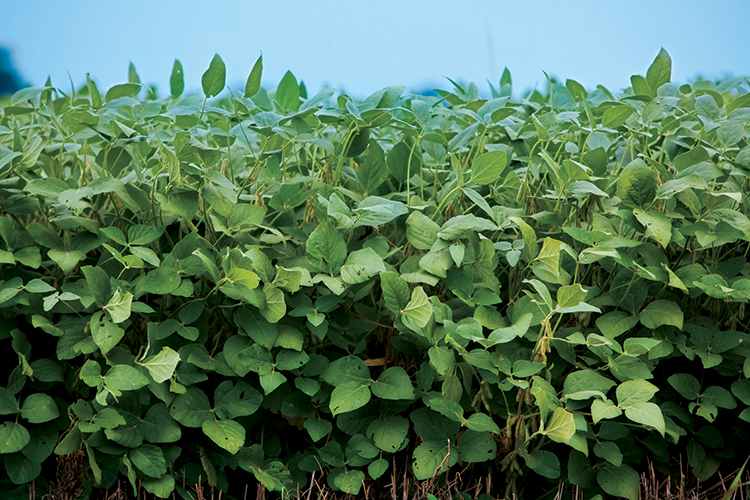Home > Arkansas > Arkansas Crops & Livestock > Rise of the Arkansas Delta
Rise of the Arkansas Delta

Known as a farming giant for nearly 200 years, the Arkansas Delta region is poised for new growth as a center of agricultural innovation and industry.
Running along the Mississippi River, stretching from north to south to the borders of Missouri and Louisiana, the Arkansas Delta emerged as an important industry hub during the nation’s early years. Varying and productive soils helped the Delta play a pivotal role in crop production.
Cotton cultivation emerged in the 1820s, eventually becoming the crop most associated with the region. Around 70 years later, rice cultivation took hold, and soybean farming followed three decades later. Over the course of a century, both the population and economy of the region exploded, thanks in large part to these key crops.
However, new farm technology and World War II in the 1940s brought a dramatic shift, altering Arkansas Delta agriculture in ways still present today.
Tractors and the mechanized cotton picker were introduced and replaced much of the once-needed manual labor. A one-row cotton picker had the capacity to replace up to 40 hand laborers, and one tractor replaced the work of five to six tenant families.
Many rural farmers also left their operations to work in defense plants and never returned, beginning a population decline that continues today. Farmers who stayed adopted the improved agricultural technology and research findings, allowing for expansion of farm operations and development of new ag industries, such as aquaculture.
Today, agriculture remains the powerhouse of the Arkansas Delta. The area accounts for a significant portion of the $20 billion that agriculture contributes to the state’s economy annually. Like producers across the state, Delta farmers take advantage of valuable research conducted by the University of Arkansas System Division of Agriculture’s Cooperative Extension Service to improve production methods, biotechnology, and conserve the area’s soil and water resources.
Arkansas producers are innovative and have experienced success with crops new to the area, such as peanuts and edamame and other specialty crops, including a few organic varieties. They are highly efficient and rapidly adopting new technology to remain competitive and productive.
As a result, state agricultural business leaders and educators are looking toward a bright future for the Delta, embracing modern technology, programs, research and business within the region.
 Strengthening the Delta
Strengthening the Delta
Wayne Miller, an extension economist for the University of Arkansas System Division of Agriculture, is working to help the Delta’s rural communities and governments adapt to opportunities provided by the global economy. He says major rural structural changes to the region in the last few decades mean the communities can no longer rely solely on their previous economic base.
“We try to help them identify their options for growing their regions and communities by using local talent and resources,” Miller says. “We encourage communities to add value to locally grown agriculture and forest commodities and develop products for niche markets, including growing high- value produce for local markets. The Community and Economic Development program also assists communities and regions identify and evaluate sustainable strategies that will benefit local residents.”
The program also helps communities identify long-term strategies to enable local governments to provide services when their local tax base may be declining. “We look at county government finance and how their tax base has changed over time, and what they can do to maintain and enhance services,” Miller says.
 Innovating the Delta
Innovating the Delta
Chris Masingill, federal co-chairman of the Delta Regional Authority, or DRA, says the region is ripe for ag and business growth.
DRA, a federal-state partnership working with U.S. Department of Agriculture-Rural Development, develops and supports the initiatives and strategies in rural communities, focusing on public infrastructure, transportation and workforce development. For example, DRA is a strong advocate for food industry and entrepreneurship opportunities in the Delta.
“The Delta region is critical to our economy,” Masingill says. “When you look at the potential that exists, particularly in the food and agricultural landscape, there are some real opportunities there.” He notes that the Delta has some of the richest farmland and most experienced farmers in the world.
Helping develop regional entrepreneurs is one of DRA’s partners, the Delta Center for Economic Development at Arkansas State University.
The Center coordinates economic development outreach services, providing a comprehensive approach to serving businesses, governments and Arkansans.
Growing the Delta
Simmons Bank, a major ag lender in Pine Bluff, is interested in the Delta’s development. Recently, the organization commissioned an economic study of the region with economist Dr. Greg Hamilton.
“The Arkansas Delta is one of the leading agricultural areas of the world,” says Rex Nelson, corporate community relations for Simmons Bank. “It matters greatly because agriculture is such a central part of the economy in this part of the country.”
As the world’s population increases, he adds, so will demand for Delta ag staples such as rice, soybeans, and others, such as poultry. “The future of Delta agriculture is very bright,” he says.



